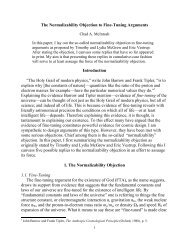Theism and Explanation - Appeared-to-Blogly
Theism and Explanation - Appeared-to-Blogly
Theism and Explanation - Appeared-to-Blogly
You also want an ePaper? Increase the reach of your titles
YUMPU automatically turns print PDFs into web optimized ePapers that Google loves.
182 Notes<br />
43. Musgrave, Essays on Realism, 284.<br />
44. Ibid., 285 (adapted).<br />
45. Timothy McGrew, as we have seen (2.1.3.1), criticises Swinburne’s view of<br />
justifi cation for denying, in effect, that the ancient Greeks would have been<br />
justifi ed in accepting P<strong>to</strong>lemaic astronomy. No such objection can be levelled<br />
at the “explanationist” view I have adopted (2.1.3.2).<br />
46. Musgrave, Essays on Realism, 285.<br />
47. Schoen, Religious <strong>Explanation</strong>s, 133.<br />
48. Leibniz, “Principles of Philosophy,” §32.<br />
49. Musgrave, Essays on Realism, 250 n.<br />
50. Lycan, Judgement <strong>and</strong> Justifi cation, 130–31.<br />
51. Ibid., 135, 148, 156, 158.<br />
52. Ibid., 155, 158.<br />
53. Ibid., 156.<br />
54. Ibid., 158–59; see also 139–44.<br />
55. Ibid., 143.<br />
NOTES TO CHAPTER 7<br />
1. As I shall argue in a moment (7.1), many philosophers regard testability as a<br />
necessary condition of at least scientifi c explanations. I would be inclined <strong>to</strong><br />
go further <strong>and</strong> regard it as a necessary condition for accepting any proposed<br />
explanation. But I would not want <strong>to</strong> make so strong a claim for all the desiderata<br />
I am about <strong>to</strong> discuss.<br />
2. . Lycan, “<strong>Explanation</strong> <strong>and</strong> Epistemology,” 416.<br />
3. Hempel, “Logical Positivism,” 191.<br />
4. Cioffi , “Freud <strong>and</strong> the Idea of a Pseudo-Science,” 472.<br />
5. Thomson, “Cathode Rays,” 294.<br />
6. Popper, Logic of Scientifi c Discovery, §31 (96), §35 (103).<br />
7. Swinburne, Is There a God?, 52.<br />
8. Ibid., 53.<br />
9. Davis <strong>and</strong> Falconer, J. J. Thomson, 123.<br />
10. Worrall, “Methodology” 46.<br />
11. As Ian McCausl<strong>and</strong> points out (“Anomalies,” 283–85), this is a contestable<br />
claim, since in 1898 Paul Gerber had already offered an explanation, using<br />
classical, New<strong>to</strong>nian mechanics, <strong>and</strong> it is still unclear whether a revised version<br />
of his proposal could be made <strong>to</strong> work. (For an on-line discussion, see<br />
Brown, “Gerber’s Gravity.”) But this fact needn’t bother us here. What is<br />
important is that known facts could, in principle, lend support <strong>to</strong> one theory<br />
over another.<br />
12. Worrall, “Methodology,” 47.<br />
13. Musgrave, Essays on Realism, 230.<br />
14. In fact, Nicod’s criterion, as discussed by Carl Hempel (Aspects of Scientifi c<br />
<strong>Explanation</strong>, 10–25), has <strong>to</strong> do with conditionals of the form “All As are B,”<br />
but I am using the phrase here in an extended sense, which would make it<br />
applicable <strong>to</strong> any hypothesis.<br />
15. Grünbaum, “Popper vs Inductivism,” 120.<br />
16. Hempel, Aspects of Scientifi c <strong>Explanation</strong>, 14–20. While not strictly a paradox,<br />
it is a puzzle. What is the puzzle? Well, if an observation confi rms H 1<br />
<strong>and</strong> if H 1 is logically equivalent <strong>to</strong> H 2 , then it also confi rms H 2 . Let’s say<br />
that H 2 is “all ravens are black” <strong>and</strong> that H 1 is “all non-black things are<br />
non-ravens,” then the observation of any non-black non-raven (let’s say, the<br />
yellow cup that is sitting on my desk) will confi rm H 1 . But the problem is that



